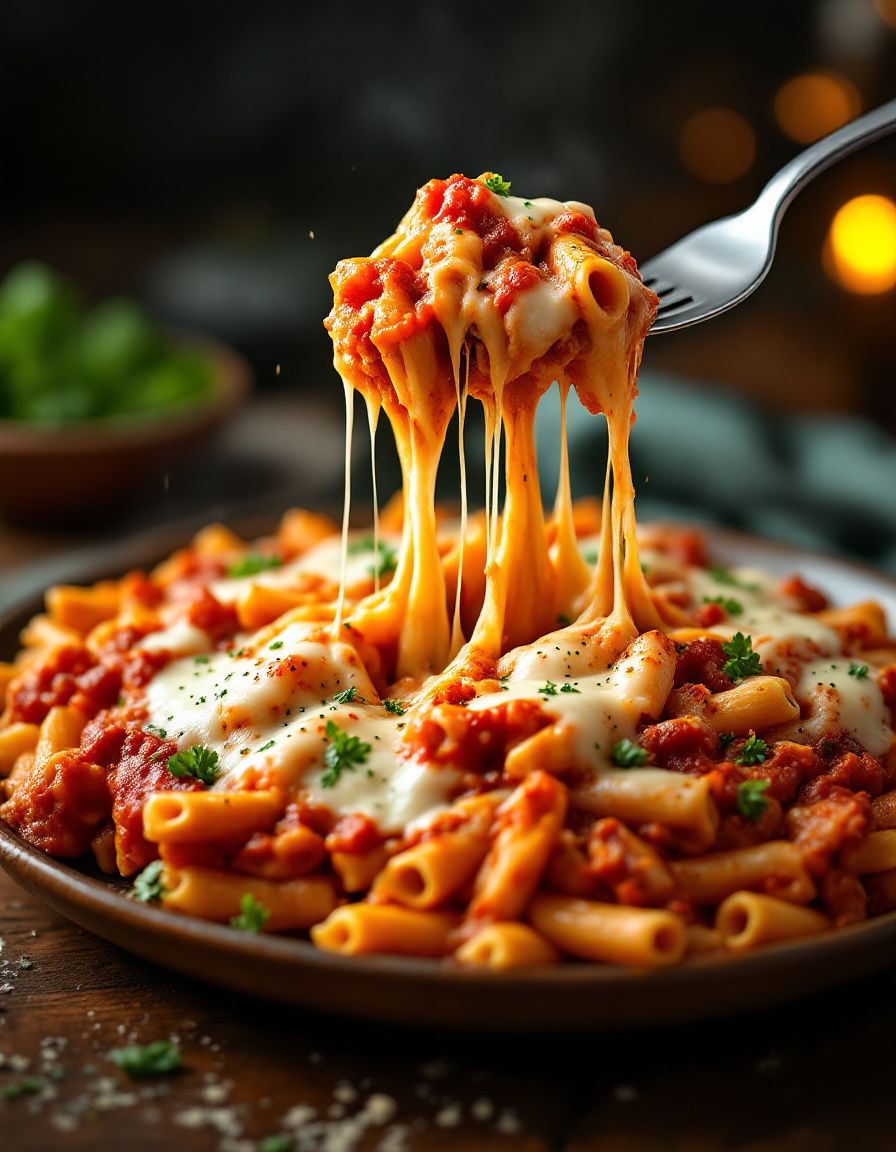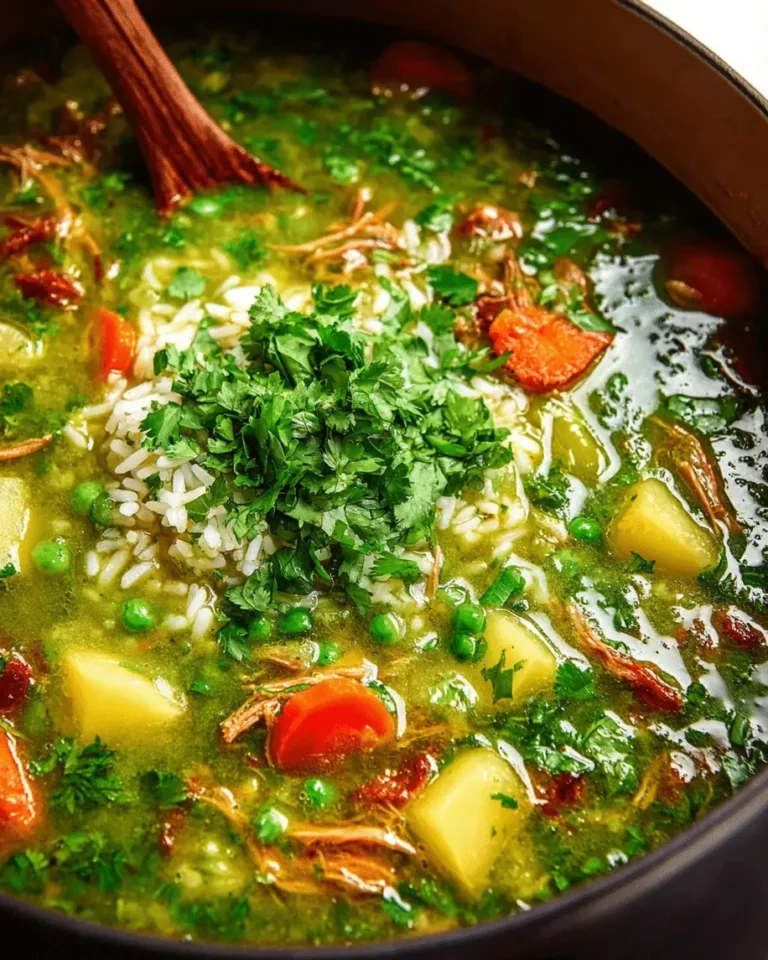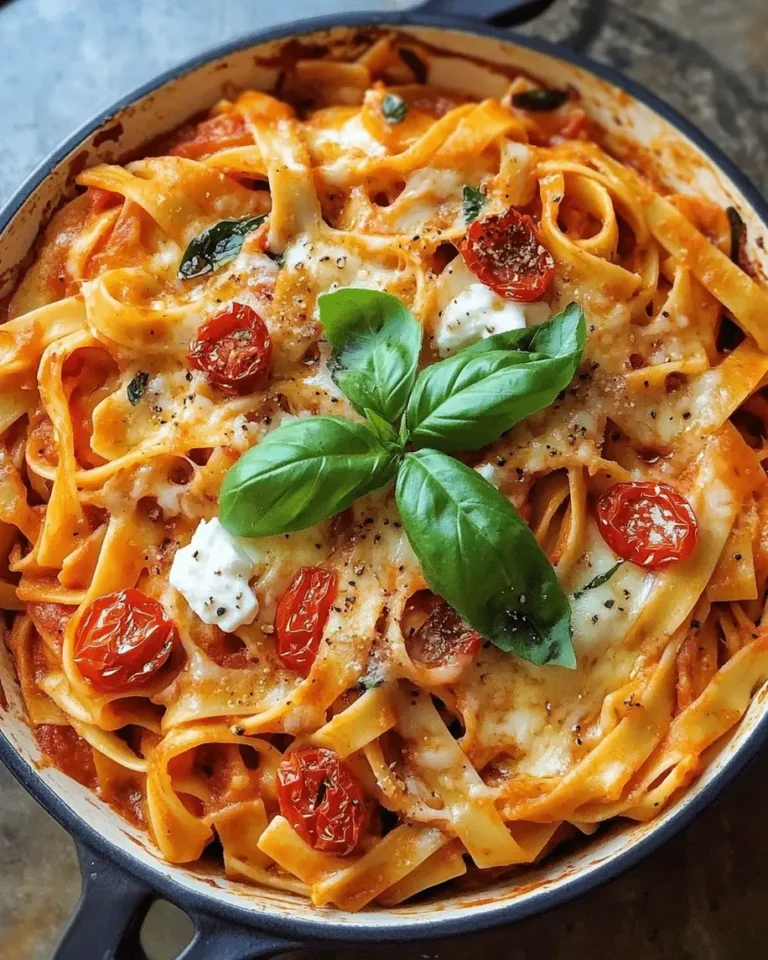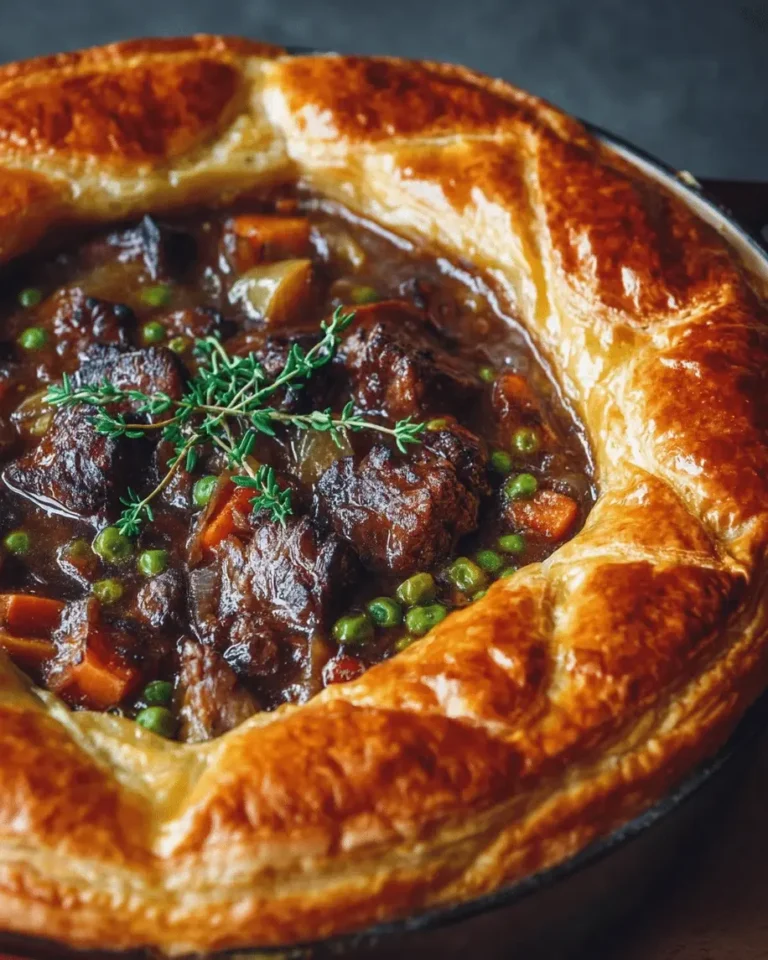Easy Slow Cooker Baked Ziti – Extra Cheesy Family Favorite

Slow Cooker Baked Ziti – So Easy & Extra Cheesy!
Indulge in the ultimate comfort food with our Slow Cooker Baked Ziti – So Easy & Extra Cheesy! This dish is a delightful blend of ziti pasta, rich marinara sauce, and an abundance of melted cheese that will make your taste buds dance with joy. Picture a creamy, cheesy layer that envelops tender noodles, served warm from the slow cooker. It’s the perfect dish for busy weekdays or when you’re hosting friends for a cozy gathering; just set it and forget it!
Baked ziti is not just delicious; it also warms the heart and soul. Each bite is bursting with flavors, and the oozy, stringy cheese is the star of the show. It’s a classic Italian-American comfort food that brings everyone around the table. Whether you enjoy it seated with family or at a potluck with friends, this dish will become a favorite for anyone who tries it!
Quick Recipe Highlights
- Flavor Profile: This baked ziti combines savory tomato sauce, rich Italian herbs, and melty cheese, creating a comforting and satisfying experience.
- Texture: The combination of al dente pasta and gooey cheese creates a delightful contrast that melts in your mouth.
- Aroma: The hearty aroma of bubbling cheese and seasoned sauce fills the kitchen, enticing everyone to gather around the table.
- Visual Appeal: Golden melted cheese dotted with herbs combined with the vibrant red of marinara sauce makes this dish visually stunning.
- Skill Level Needed: This is perfect for beginners or anyone seeking a fuss-free dish that requires minimal hands-on time.
- Special Equipment: A slow cooker is essential, making this dish easy to prepare for busy days.
Recipe Overview
- Difficulty Level: This recipe is approachable and simple, making it ideal for beginner cooks or those short on time.
- Category: Baked Ziti falls under the pasta dinner category, perfect for comforting family meals.
- Cuisine: This dish is rooted in Italian-American cuisine, featuring classic flavors that have evolved in the US.
- Cost: With reasonable ingredient prices, this dish offers great value for money, feeding a crowd without breaking the bank.
- Season: Enjoy this meal year-round, especially during colder months when you crave warmth and comfort.
- Occasion: Baked ziti is an excellent choice for family dinners, potlucks, and casual gatherings.
Why You’ll Love This Recipe
Taste and texture are at the forefront of this Slow Cooker Baked Ziti. The combination of hearty, baked pasta intertwined with savory marinara sauce and an over-the-top layer of cheese makes each bite a comforting experience. Flavorful spices and herbs enhance the dish, ensuring every mouthful is packed with taste, creating an irresistible meal that everyone will enjoy.
The convenience of slow cooking is another great benefit. You simply prepare the ingredients, layer them in the cooker, and let it do its magic. This recipe takes the stress out of meal preparation, allowing you to spend quality time with your family or guests while dinner cooks itself. No need to hover over the stove; just set it and enjoy your evening.
Nutritionally, baked ziti offers a good balance of carbohydrates from the pasta, protein from cheese, and vitamins from the marinara sauce. It’s a filling meal that brings both satisfaction and comfort, making it a hit among kids and adults alike. You can also sneak in some veggies if you want to boost its nutritional value!
Socially, this dish works wonders in bringing people together. Whether at a family gathering or a casual dinner party, Baked Ziti evokes warmth and togetherness. The cheesy, hearty nature of the dish encourages sharing, making it an excellent option for entertaining.
Cost-effectiveness is another advantage of this recipe. You can feed a crowd with relatively inexpensive ingredients, making it perfect for anyone trying to save money on meals without sacrificing flavor. Leftovers can easily be repurposed for lunch the next day, giving you even more value.
Historical Background and Cultural Significance
The origin of baked ziti can be traced back to Southern Italy, where pasta dishes were traditionally baked. However, it gained popularity in the United States as Italian immigrants introduced their culinary traditions, adapting them with locally available ingredients. Baked ziti emerged as a hearty, family-friendly dish that quickly became beloved across the country.
Culturally, baked ziti holds a significant place in Italian-American communities. It’s commonly served during family gatherings, holidays, and celebratory occasions, symbolizing togetherness and shared meals. The tradition of combining pasta with various sauces also highlights the resourcefulness of Italian cooking, allowing for creative variations.
Over time, baked ziti has evolved, welcoming engaged cooks to experiment with ingredients. From the classic recipe featuring ricotta and mozzarella to variations including vegetables or different protein types, the dish reflects the ever-changing palate of contemporary diners while keeping its comforting roots.
Regional variations of baked ziti can be found across the United States. In some areas, it may incorporate spicy sausage or be topped with breadcrumbs for added crunch. These adaptations showcase the adaptability of the dish, confirming its hold in American dining culture.
Ingredient Deep Dive
Ziti Pasta
Ziti pasta is a staple in baked dishes, known for its tubular shape and ability to hold onto sauce. With its origins in Southern Italy, ziti is often used in hearty baked dishes, making it ideal for casseroles like baked ziti. Nutritionally, ziti is primarily composed of carbohydrates, providing energy, but it can also be a source of fiber if made from whole grains. When selecting ziti, look for high-quality pasta that is firm to the touch. Store dried ziti in a cool, dry place, while cooked ziti should be refrigerated and used within 3-5 days. If you need a substitution, penne or rigatoni can work in its place.
Marinara Sauce
Marinara sauce is the classic accompaniment to baked ziti. This tomato-based sauce is characterized by its savory and slightly sweet flavor. It holds significant cultural importance in Italian cuisine, being a versatile sauce that pairs beautifully with a variety of pasta dishes. Nutritionally, marinara provides several vitamins, particularly vitamin C and lycopene, which has antioxidant properties. When selecting a marinara sauce, prefer options with wholesome ingredients and without added sugars. Store-bought sauces should be used within their shelf life, while homemade marinara can be refrigerated for up to a week. A good substitute could be a homemade tomato sauce or store-bought spaghetti sauce.
Cheese Mixture
The cheese mixture, usually consisting of ricotta, mozzarella, and parmesan, adds the signature cheesy goodness of baked ziti. Each cheese contributes its unique flavor, with ricotta providing creaminess, mozzarella offering meltiness, and parmesan delivering sharpness. Cheese has long been a significant ingredient in Italian dishes, prized for its rich taste and texture. In terms of nutrition, cheese is a good source of calcium, protein, and vitamins, though it should be consumed in moderation. Look for fresh cheeses with minimal additives for the best quality. Store cheese in the refrigerator, tightly wrapped to maintain freshness. If needed, you can substitute ricotta with cottage cheese or use vegan cheese alternatives.
Common Mistakes to Avoid
- Overcooking the pasta: It’s essential to cook the ziti al dente since it will continue to soften while baking in the slow cooker. Overcooked pasta can become mushy and lose its shape.
- Using too much sauce: While marinara is crucial, too much of it can make the dish soupy. Aim for a balanced ratio of sauce to pasta to achieve a perfect consistency.
- Not allowing flavors to meld: Take time to let the ingredients sit before serving to allow the flavors to blend. It enhances the overall taste of the dish.
- Choosing low-quality cheese: The quality of your cheese impacts the flavor. Opt for fresh, high-quality cheeses for the best results.
- Ignoring layering techniques: Properly layer the pasta, sauce, and cheese to avoid uneven cooking and ensure every bite is packed with flavor.
- Skipping the seasoning: Don’t overlook seasoning; adding herbs and spices can elevate your dish, providing a more robust flavor profile.
- Not using enough cheese: Cheesy baked ziti should be an indulgent treat, so don’t skimp on the cheese layer, which is essential for the classic creamy texture.
- Not greasing the slow cooker: Ensuring your slow cooker is well-greased will help prevent sticking and make cleanup much easier.
- Forgetting to check the cook time: Depending on your slow cooker model, cook times may vary. Regularly check to ensure your dish is cooking properly.
- Neglecting to let it rest: Allow the baked ziti to sit for a few minutes before serving. This helps it set and makes it easier to portion out.
Essential Techniques
The key technique in making baked ziti is layering. Layering helps distribute the flavors throughout the dish. Start with a layer of sauce, followed by ziti, cheese mixture, and repeat until you’ve used up your ingredients. Mastering this technique ensures that every slice includes all components, creating a harmonious dish.
Another important technique is cheese melting. To achieve the ultimate cheese pull, use fresh cheeses, and cover the slow cooker towards the end of cooking to trap moisture and enhance meltability. Visual cues for success include a bubbling surface and a golden-brown cheese layer.
Pro Tips for Perfect Slow Cooker Baked Ziti
1. Use fresh ingredients whenever possible. Fresh herbs and high-quality cheeses elevate the flavors of your dish.
2. Pre-cook the sauce if you want deeper flavors. Sautéing garlic and onion before adding tomatoes can enhance richness.
3. Remember to slice the cheese for better distribution; it melts more evenly throughout the dish.
4. If desired, add cooked vegetables like bell peppers, spinach, or zucchini for a nutrient boost and added texture.
5. Experiment with different cheeses to find your personal favorite combination. A mix of gouda and mozzarella can add an interesting flavor profile.
6. Notice the cooking time; adjust according to the consistency you’d like. If you prefer a firmer texture, aim for less cooking time.
7. For a crispy topping, briefly place the dish under the broiler after cooking to create a delightful golden crust.
8. Consider using leftover meats or sausage for added flavor and protein density.
Variations and Adaptations
Baked ziti can be customized to fit regional and personal preferences. For instance, Southern-style baked ziti can include spicy Italian sausage, while vegetarian versions can be enhanced with roasted vegetables or a medley of mushrooms, ensuring all diners are accommodated.
Seasonal adaptations can also be incorporated, using late summer’s fresh tomatoes and basil for a brighter flavor. During the colder months, adding seasonal vegetables like butternut squash can provide a rich, hearty touch.
Dietary modifications can make this dish suitable for various eating plans. For gluten-free options, using gluten-free ziti or another gluten-free pasta works perfectly. Vegan adaptations can include cashew cheese or any plant-based alternative, allowing everyone to enjoy this classic dish.
Flavor variations such as a spicy version with crushed red pepper or a creamy version with Alfredo sauce can offer unique takes on the classic recipe. Finally, for an elevated presentation, consider serving the baked ziti in individual portions with a sprig of fresh basil topping each serving.
Serving and Presentation Guide
Plating baked ziti can be simple yet elegant. Use a large serving spoon to gently scoop out portions into bowls or plates. For added visual appeal, consider garnishing with fresh herbs like parsley or basil, which add a pop of color and a fresh taste. Pair it with a simple salad or garlic bread to complete the meal.
Traditional accompaniments such as a Caesar salad or garlic bread work beautifully with baked ziti, enhancing the overall dining experience. Modern serving suggestions can include placing individual portions inside mini cast iron skillets for a rustic look.
Be mindful of serving temperature; warm baked ziti tastes best. Allow it to sit for a few minutes post-cooking to let the flavors develop and ensure it’s not too hot for your guests. For portion control, a standard serving is about 1-1.5 cups, which can be adjusted based on appetite and sides served.
Wine and Beverage Pairing
When it comes to pairing wine with baked ziti, consider a medium-bodied red such as Chianti or Sangiovese. These red wines complement the richness of the tomato sauce and cheese, enhancing the overall flavor of the meal.
For non-alcoholic alternatives, sparkling water with a dash of lemon can cleanse the palate between bites while providing a refreshing contrast to the richness of the dish. For those who prefer coffee, a bold, dark roast can go surprisingly well with baked ziti, particularly in cooler weather.
Serving temperatures are crucial: wines should be served at standard room temperature unless noted otherwise, while sparkling beverages can be enjoyed chilled. To entice guests further, consider creating a small beverage station where they can choose their favorite drinks.
Storage and Shelf Life
Storing baked ziti requires proper techniques to maintain its taste and texture. After cooking, allow it to cool completely before transferring it into an airtight container. Refrigerate baked ziti within two hours to keep it fresh, where it can last for about 3-5 days.
For longer storage, consider freezing. Baked ziti freezes well; simply wrap it tightly in plastic wrap and then aluminum foil to prevent freezer burn. When it comes to reheating, do so gradually in the oven, ensuring it heats evenly and remains delicious.
Signs of spoilage include off odors or unusual textures. Always inspect your food before consumption, and if in doubt, it’s safer to discard it. When reheating, aim for an internal temperature of 165°F to ensure it’s warmed safely throughout.
Make Ahead Strategies
Making baked ziti ahead of time can be a kitchen lifesaver. Prep your ingredients and layer them into your slow cooker insert within a day of cooking. Store any remaining ingredients separately in the refrigerator until you’re ready to cook.
A timeline for prep can help streamline the process. Pre-cook your sauce a day ahead to enhance flavors, allowing it to cool before assembling. Assemble just before it’s time to start cooking for the freshest taste.
Quality impact is minimal when making baked ziti ahead of time, allowing the flavors to meld overnight. If you assemble the dish the night before, just be mindful to add a bit of extra cooking time to ensure everything heats through properly.
If you wish to add fresh elements like herbs or cheese, wait until right before serving to preserve their vibrant flavor. Reheating guidelines remain the same: aim for an internal temperature of 165°F to achieve the perfect consistency and temperature.
Scaling Instructions
Scaling the Slow Cooker Baked Ziti recipe can be done easily by altering the quantities of the ingredients. If you want to halve the recipe, consider using a smaller slow cooker or cooking the remaining ziti as a second batch.
Doubling or tripling the recipe can be efficient for larger gatherings, but it’s crucial to ensure your slow cooker is large enough for the increased volume. If you’re cooking for an even bigger crowd, a commercial-sized slow cooker might be necessary.
Timing modifications may be needed for larger batches; expect to increase the cooking time slightly, particularly if the mixture is denser. For storage considerations, same guidelines apply: use airtight containers and ensure they are labeled to avoid confusion later.
Nutritional Deep Dive
When examining the nutritional content of Slow Cooker Baked Ziti, a macro breakdown reveals rich sources of carbohydrates from the pasta, along with proteins from the cheese, and healthy fats from olive oil or cheese. Each serving is balanced, making it a great choice for an energizing meal.
Micronutrients included in the dish primarily come from tomatoes in the marinara and any added vegetables. Expect to find vitamin C, potassium, and B vitamins that contribute to overall health and functioning.
Consideration of health benefits should also extend to portion control. Baked ziti is hearty, but its rich ingredients can be calorie-dense. Knowing your serving sizes can help maintain a balanced diet without excess calorie intake.
Additionally, those looking to manage their weight may find it beneficial to load their baked ziti with vegetables or choose whole-grain pasta to add fiber and nutrients. This can facilitate weight management goals while still delivering a satisfying meal.
Dietary Adaptations
For gluten-free versions of Slow Cooker Baked Ziti, simply substitute regular pasta with gluten-free options such as rice or lentil pasta. This adjustment allows those with gluten sensitivities to enjoy the same beloved recipe without the discomfort.
Dairy-free adaptations involve swapping traditional dairy products for plant-based alternatives. Using cashew cheese or almond milk-based cheese can provide similar textures and flavors without the dairy, making the dish vegan-friendly.
For those following specific dietary plans, low-carb variations can utilize spiralized zucchini in place of traditional pasta, conforming to keto or other low-carb preferences. You can also incorporate protein sources like lentils or chickpeas for a nutritious twist.
Other considerations could involve a low-FODMAP version by using lactose-free cheese and ensuring no high-FODMAP ingredients are included. This allows for even more inclusivity among varying dietary needs.
Troubleshooting Guide
Texture issues can arise, particularly if the pasta is overcooked. To avoid mushiness, it’s crucial to follow the cooking time and ensure the pasta is cooked al dente to retain some bite.
Flavor balance can be off if there isn’t enough seasoning or if the sauce is too strong. Adjust by gradually adding spices or acids like lemon juice, tasting as you go to reach the perfect equilibrium.
Temperature problems may occur when reheated portions aren’t warm enough. Ensure that the dish is evenly reheated by stirring it during reheating or checking that the center heats to 165°F.
Equipment challenges typically arise, such as slow cooker sizes. Using an appropriately sized cooker is essential; if your cooker is too small, you might overflow or undercook your ziti.
Ingredient substitutions can be tricky; knowing your replacements can help maintain the dish’s integrity. Research your alternatives to ensure they add the flavors you desire effectively.
Timing concerns, especially if dinner is approaching and the dish isn’t done yet, can often be solved by opting for higher cooking settings or pre-cooking certain components beforehand to speed up the process.
Recipe Success Stories
Numerous readers have shared their glowing feedback, praising the ease of preparation and the incredible flavors of baked ziti. Many have noted how successful it is for family dinners, where everyone leaves satisfied and happy.
Adaptation stories often highlight successful tweaks by readers, from adding extra vegetables to experimenting with different cheeses, showcasing how versatile this dish can be.
Photography tips have been popular amongst users as well; vibrant presentations topped with fresh basil or garnished with a sprinkle of parmesan have helped capture the indulgent nature of baked ziti, perfect for social sharing.
Community suggestions have encouraged even more experimentation, leading to discussions around the best sauces, pasta shapes, and flavor combinations, further enriching the recipe’s legacy.
Frequently Asked Questions
Cooking baked ziti in a slow cooker typically takes 6-8 hours on low or 3-4 hours on high, depending on your slow cooker model and the amounts used. Always ensure internal temperature reaches 165°F before consuming.
Can I prepare baked ziti ahead of time?
Yes! You can assemble the baked ziti ahead of time and store it in the refrigerator. Just ensure it’s well-wrapped, and when you’re ready to cook, allow it to come to room temperature before placing it in the slow cooker.
What can I substitute for ziti?
If you’re out of ziti, you can use any tubular pasta shape like penne or rigatoni as a substitute while keeping the classic flavor and texture intact.
Is baked ziti freezable?
Absolutely! Baked ziti freezes well. Just let it cool completely, wrap tightly with plastic and foil, and it will be good for 2-3 months in the freezer. Reheat thoroughly before serving.
How do I make baked ziti vegetarian?
Make your baked ziti vegetarian by omitting any meat and adding extra vegetables like spinach, bell peppers, or mushrooms to enhance the flavor and nutrition.
Can I use store-bought sauce?
Yes! Store-bought marinara sauce saves time and adds great flavor. Just choose one without added sugars or preservatives for the best results.
Does the cheese have to be fresh?
Fresh cheese, like mozzarella, melts better and provides a creamier texture. While shredded cheeses can work, the results will be less creamy. Consider buying blocks or fresh cheese for the best outcome.
What is the best way to reheat baked ziti?
To reheat baked ziti, place it in the oven at 350°F until heated through, typically 20-30 minutes. Cover with foil to prevent browning while reheating.
Can I add meat to this recipe?
Yes! You can incorporate cooked ground beef, sausage, or chicken into the layers of your baked ziti for an added protein kick.
Can baked ziti be spicy?
Absolutely! You can add crushed red pepper flakes or spicy sausage while cooking to give the dish a kick that complements the classic flavors perfectly.
Additional Resources
If you enjoyed this Slow Cooker Baked Ziti, try other comforting recipes like Lasagna or Mac and Cheese for more cheesy goodness. Our technique guides for pasta cooking and slow cooking can also provide valuable tips. For ingredient information, we have databases on pasta and sauces that deepen culinary knowledge, while equipment recommendations help ensure you have the right tools for the job. Finally, seasonal variations on baked dishes around the holidays can lead to delightful culinary explorations.
Join the Conversation
We encourage you to share your experiences and photos of your baked ziti creations on social media! Discover new variations and adaptations by interacting with our cooking community. Your recipe reviews help others find the best ideas for their meals, fostering a shared love for comfort food. We invite you to engage with us and share your most creative and successful baked ziti moments with the world!
The Recipe
Slow Cooker Baked Ziti
Serves: 8 servings
Prep Time: 15 mins
Cook Time: 6-8 hours
Total Time: 6-8 hours 15 mins
Kitchen Equipment Needed
- Slow cooker
- Large mixing bowl
- Cooking spoon
- Baking dish (optional, for serving)
Ingredients
- 1 pound ziti pasta
- 4 cups marinara sauce
- 15 ounces ricotta cheese
- 2 cups mozzarella cheese, shredded
- 1/2 cup parmesan cheese, grated
- 1 teaspoon dried Italian herbs
- Salt and pepper to taste
Directions
- Cook ziti pasta according to package instructions until al dente; drain and set aside.
- In a large mixing bowl, combine ricotta cheese, half of the mozzarella, parmesan, Italian herbs, salt, and pepper.
- In the slow cooker, layer half of the marinara sauce, half of the pasta, and half of the cheese mixture. Repeat the layers.
- Top with the remaining marinara sauce and sprinkle with the remaining mozzarella cheese.
- Cover and cook on low for 6-8 hours or high for 3-4 hours until everything is heated through and gooey.
Recipe Notes
- Feel free to substitute pasta or cheese as desired.
- Adding cooked vegetables or meats can elevate the dish.
- Leftovers can be stored in the refrigerator for 3-5 days, or frozen for up to 3 months.






